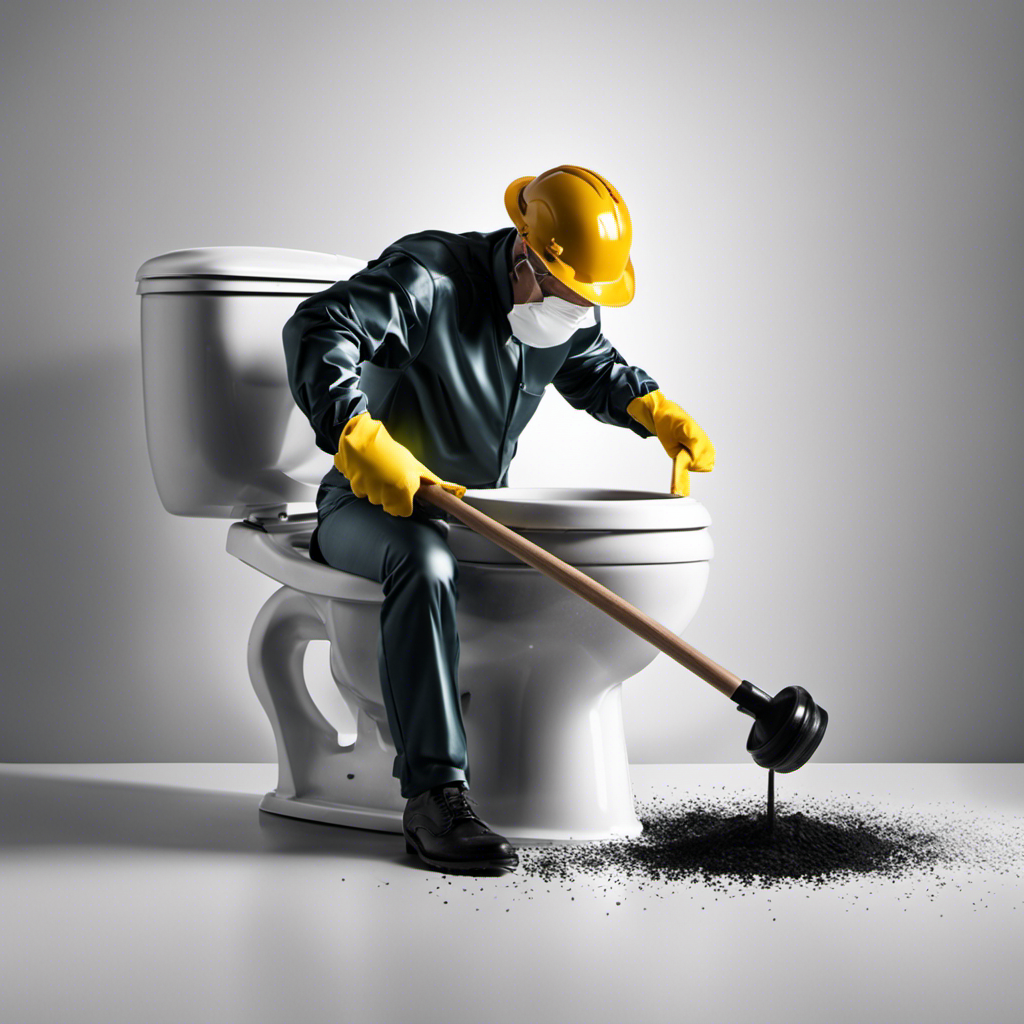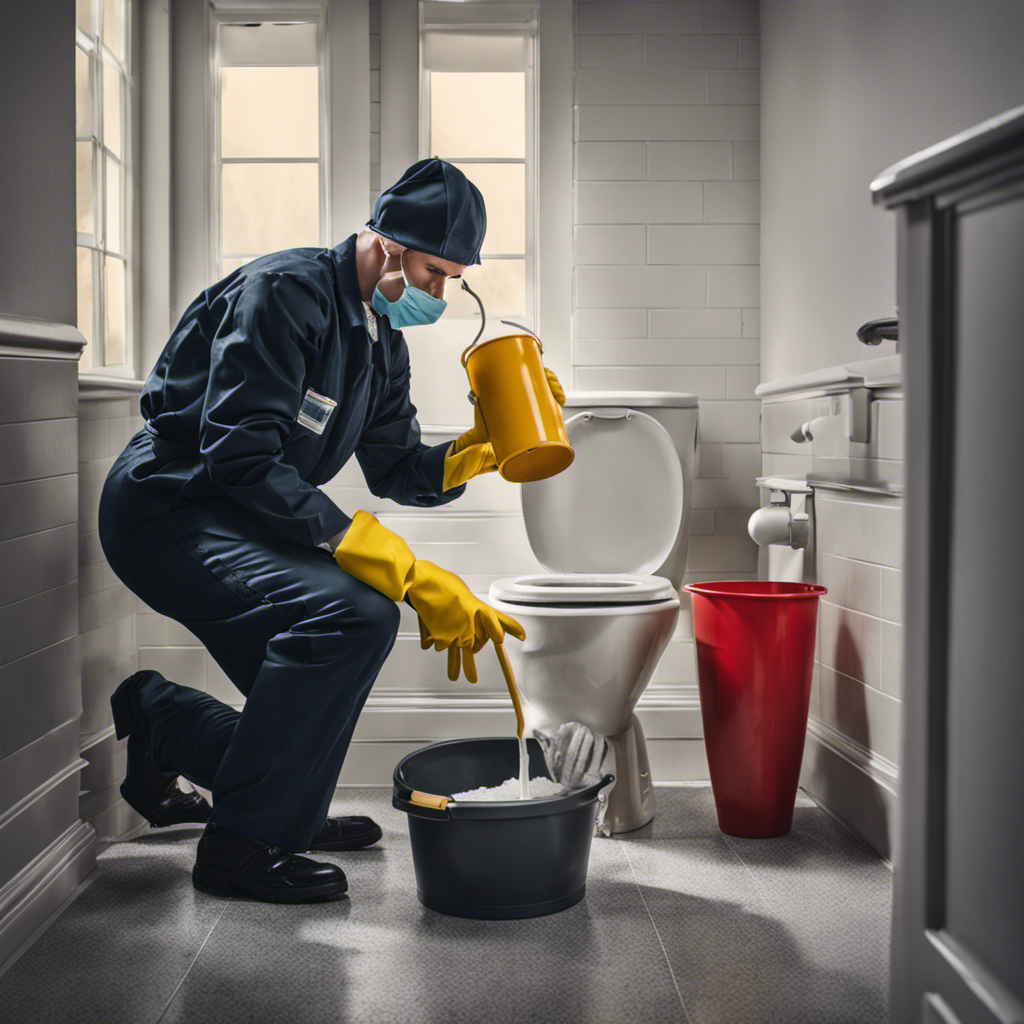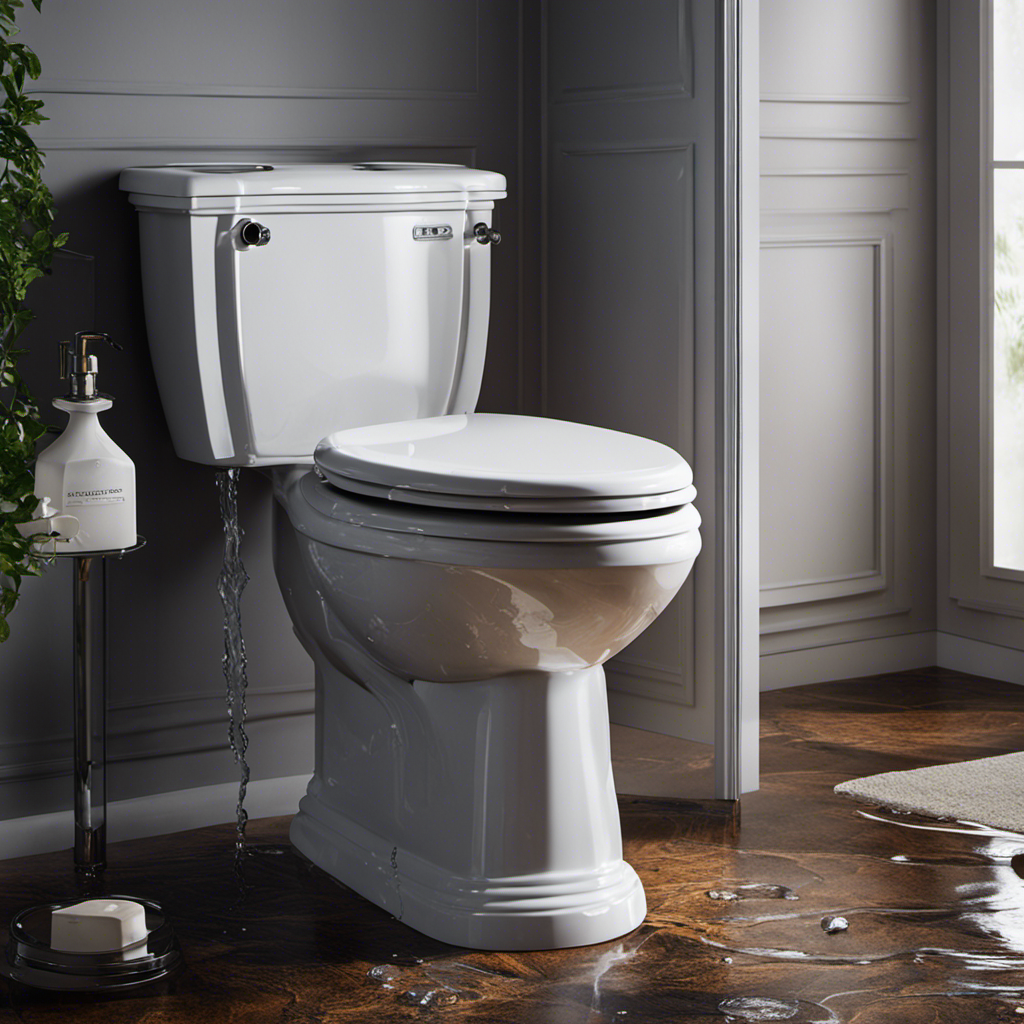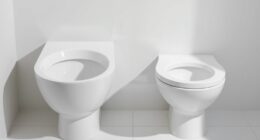I’ve tackled my fair share of DIY projects, but there’s something uniquely satisfying about successfully removing a toilet bowl.
Picture the feeling of accomplishment as you confidently disconnect the bowl from the floor, knowing that you’re one step closer to completing your bathroom renovation.
In this guide, I’ll walk you through the precise steps and tools you’ll need to get the job done right.
So, let’s roll up our sleeves and dive into the world of toilet bowl removal.
Key Takeaways
- Ensure the water supply is turned off and wear gloves for protection during the removal process.
- Locate the shut-off valve and repair any leaks in the water supply line before removing the toilet bowl.
- Flush the toilet multiple times to empty the water and clean the bowl thoroughly.
- Disconnect the water supply line from the tank, flush the toilet to drain the tank, and then lift the tank off the bowl.
Preparing the Tools and Supplies
Before you start removing the toilet bowl, make sure you have all the necessary tools and supplies. Safety precautions should always be taken when working with toilets.
First, ensure that the water supply to the toilet is turned off to prevent any leaks or spills. Next, wear gloves to protect your hands from any potential bacteria or germs.
Cleaning and sanitizing the area around the toilet is essential to maintain hygiene. Use a disinfectant cleaner and a brush to scrub the toilet bowl and surrounding areas thoroughly.
Additionally, gather the required tools such as a wrench, plunger, and putty knife. These tools will help in loosening and removing the toilet bowl securely.
Proper preparation and cleanliness are crucial before attempting to remove a toilet bowl.
Shutting Off the Water Supply
To prevent any water leakage, make sure you’ve shut off the water supply before starting the removal process. This is an important step in ensuring a smooth and hassle-free toilet bowl removal. Here are some key points to keep in mind:
-
Locate the shut-off valve: The shut-off valve is usually located near the base of the toilet bowl or on the wall behind it. It is typically a small knob or lever that can be turned clockwise to shut off the water flow.
-
Repairing a leaking water supply line: If you notice any leaks or damage to the water supply line, it is important to repair it before proceeding. This can be done by replacing the damaged section of the pipe or using a sealant to fix any small leaks.
-
Replacing a faulty shut off valve: If the shut-off valve itself is faulty or not functioning properly, it may need to be replaced. This can be done by turning off the main water supply to the house, removing the old valve, and installing a new one.
Draining the Toilet Bowl
Once the water supply is shut off, you can start draining the toilet bowl by flushing it multiple times.
Flushing the toilet bowl not only helps to empty the water, but it also helps to clean the toilet bowl. When you flush the toilet, the water rushes through the bowl and carries away any debris or residue along with it.
It is important to flush the toilet multiple times to ensure that all the water is drained and the bowl is thoroughly cleaned. By flushing the toilet repeatedly, you can be confident that the bowl is free from any remaining water, making it easier to remove and clean the toilet bowl during the next steps of the process.
Removing the Toilet Tank
First, you’ll need to disconnect the water supply line from the toilet tank. This is an important step when removing the toilet tank for repair or installation.
Here’s a step-by-step guide on how to remove the toilet tank:
-
Turn off the water supply valve located near the base of the toilet.
-
Flush the toilet to drain the water from the tank.
-
Use a wrench to loosen the nut connecting the water supply line to the bottom of the tank.
-
Once the nut is loosened, carefully remove the water supply line from the tank.
-
Next, locate the bolts that secure the tank to the bowl. These are usually located on the bottom of the tank.
-
Use a wrench to unscrew the nuts from the bolts.
-
Once the nuts are removed, lift the tank off the bowl and set it aside.
Disconnecting the Toilet Bowl From the Floor
Now, you’ll need to locate the bolts that attach the toilet bowl to the floor. These bolts are usually found on either side of the toilet base, near the floor. Once you have located them, use a wrench or pliers to loosen the nuts that secure the bolts in place. Make sure to hold the bolt steady while loosening the nut to prevent the bolt from spinning. Once the nuts are loose, carefully lift the toilet bowl straight up to disconnect it from the floor. Be cautious as the bowl may still have some water in it. To prevent any spills, it’s a good idea to have a bucket or towels nearby. With the toilet bowl disconnected, you can now move on to removing the wax ring and preparing for installation.
| Column 1 | Column 2 | Column 3 |
|---|---|---|
| Locate bolts | Use wrench or pliers | Lift toilet bowl |
| Loosen nuts | Hold bolt steady while loosening | Disconnect from floor |
| Be cautious | Have bucket or towels nearby | Remove wax ring |
| Prepare for installation |
Removing the Toilet Bowl
When removing a toilet bowl, there are a few key points to keep in mind.
Firstly, you will need a set of tools including a wrench, pliers, and a putty knife to assist in the removal process.
Secondly, it is important to use proper lifting technique to prevent injury and ensure a smooth removal.
And finally, once the old bowl is removed, it is crucial to properly dispose of it in accordance with local regulations.
Tools Needed for Removal
To remove a toilet bowl, you’ll need a few tools. Here are the necessary tools for the job:
-
Wrench: A wrench will be needed to loosen and remove the nuts securing the toilet to the floor.
-
Screwdriver: A screwdriver is essential for removing the bolts that hold the toilet seat in place.
-
Putty Knife: A putty knife will come in handy for scraping away any old caulk or adhesive around the base of the toilet.
-
Bucket: It’s important to have a bucket nearby to catch any water that may spill during the removal process.
-
Gloves: To protect your hands from any germs or bacteria, it is recommended to wear gloves while working on the toilet.
-
Safety Glasses: Safety glasses are necessary to protect your eyes from any debris that may fly around during the removal process.
-
Dust Mask: A dust mask will help filter out any dust or particles that may be released when removing the toilet.
Proper Lifting Technique
Make sure you bend your knees and use your leg muscles to lift the toilet bowl, avoiding any strain on your back. Proper lifting technique is crucial to ensure safety and prevent injuries. Here are some important safety precautions to keep in mind when removing a toilet bowl:
| Safety Precautions |
|---|
| Wear protective gloves to avoid direct contact with any germs or bacteria. |
| Clear the surrounding area of any obstacles or objects that may hinder your movement. |
| Use a sturdy and reliable lifting tool, such as a toilet bowl lifter or suction cup, to get a good grip on the bowl. |
| Have a partner assist you in lifting the bowl to evenly distribute the weight and minimize the risk of dropping it. |
| Take your time and move slowly and carefully to avoid sudden movements or jerks that could cause accidents. |
Disposing of Old Bowl
First, you should carefully wrap the old toilet bowl in a thick trash bag to prevent any leaks or spills during disposal. Once the bowl is securely wrapped, you have several disposal options to consider. Here are three sub-lists to explore:
Disposal Options:
- Contact your local waste management facility to inquire about their guidelines for disposing of toilets. They may have specific instructions or designated drop-off locations.
- Hire a professional junk removal service to handle the disposal for you. They have the knowledge and equipment to safely remove and dispose of the toilet bowl.
- Check if your municipality offers a bulk waste pickup service. They may have specific days or requirements for disposing of larger items like toilets.
Recycling Options:
- Some recycling centers accept porcelain toilets for recycling. Check with your local recycling facility to see if they accept toilets and what their guidelines are.
- Consider repurposing the toilet bowl for a DIY project. With a little creativity, you can transform it into a unique planter, outdoor bench, or decorative piece.
- Explore online platforms or local communities for individuals or organizations that might be interested in salvaging or upcycling old toilet bowls.
Remember to always follow proper disposal guidelines and consider recycling options to minimize waste and protect the environment.
Frequently Asked Questions
How Do I Know if My Toilet Bowl Needs to Be Removed?
If you’re wondering if your toilet bowl needs to be removed, look out for signs of a damaged toilet bowl such as cracks, leaks, or constant clogging. Regular toilet bowl maintenance can also help prevent bigger problems.
Can I Remove the Toilet Bowl Without Shutting off the Water Supply?
I once tried removing a toilet bowl without shutting off the water supply. Let’s just say it turned into a mini flood in my bathroom. Trust me, always shut off the water before attempting any toilet removal.
What Should I Do if the Toilet Bowl Is Stuck to the Floor?
If the toilet bowl is stuck to the floor, there are a few things I can do. First, I should inspect the wax ring and bolts for any signs of damage. Then, I can use a pry bar to gently loosen the bowl from the floor.
Are There Any Safety Precautions I Should Take While Removing the Toilet Bowl?
When removing a toilet bowl, it’s important to take safety precautions. Wear gloves and eye protection. Use a wrench to disconnect the water supply and a pry bar to loosen the bolts.
Can I Reuse the Wax Ring When Reinstalling the Toilet Bowl?
Yes, you can reuse the wax ring when reinstalling the toilet bowl, but it’s not recommended. Wax rings can lose their shape and effectiveness. It’s best to use a new wax ring or explore alternative sealing methods.
Conclusion
In conclusion, removing a toilet bowl may seem like a daunting task, but it can be done smoothly with the right tools and knowledge. By following the steps outlined in this article, you can successfully disconnect the toilet bowl from the floor and remove it without any hassle.
Remember to shut off the water supply and drain the bowl before starting the process. With a little bit of elbow grease, you’ll have that old toilet bowl out of your bathroom in no time, leaving you feeling as light as a feather.










